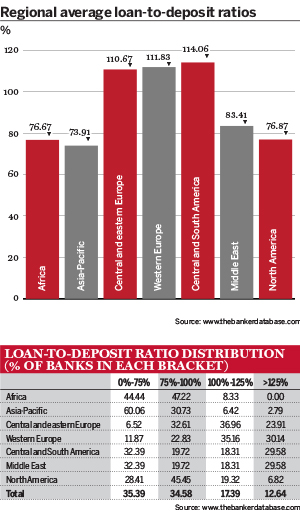Loan-to-deposit (LTD) ratios across the globe have been falling in recent years, as banks have sought to build more resilient balance sheets and demand for loans has decreased. In 2012's Top 1000 World Banks ranking, the global ratio was 99%, one year later it was 90.6% and in 2014 it dipped to 88.1%. In the 2015 ranking, this downward trend has slowed significantly and, for the 944 banks where this information is available, the ratio is 87.24%.
On a regional level, declines in LTD ratios were also less pronounced than in the recent past. The largest change took place in central and eastern Europe, where a 1.82 percentage point drop in the aggregate LTD ratio brought into check an expansion of this figure that the region posted in the 2014 ranking. In the Middle East, the ratio fell by an equally significant 1.8 percentage points, as local banks reduced their exposure to loans. In Africa, the decline was smaller, but enough to give the region the second lowest aggregate LTD ratio globally, at 76.67%. The proportion of African banks with an LTD ratio of more than 100% grew by 5 percentage points, to 8.33%, still the lowest figure worldwide.
Starting from a low base, US and Canadian institutions also saw their ratio decrease. At 76.87%, the banks have one of the lowest loan exposures globally, caused, at least in part, by the fact that capital markets are the preferred form of corporate funding in North America, depressing the demand for loans.
The most notable growth story this year comes from western Europe. The region has seen its LTD ratio depreciate in past years, as the eurozone crisis necessitated deleveraging at many banks. But in 2014 the ratio increased slightly to 111.83%, pointing at a possible recovery. Unlike their counterparts in the US and Canada, western European corporations typically use bank loans as the source of funds, one of the reasons why 65.3% of the region's banks have an LTD ratio of more than 100%, a higher proportion than anywhere else in the world.
Central and South America saw its aggregate LTD ratio grow by 1.25 percentage points to 114.06%, giving it the highest LTD ratio in the world. This growth is in contrast to the 2014 ranking, when concerns about the level of debt drove indebtedness on the continent down. Unlike in western Europe, this build up of debt is a relatively new characteristic of the local business model. Just four years ago, in the 2011 Top 1000 ranking, the aggregate LTD ratio in Central and South America was 98.94%. Thus, it is difficult to predict whether this growth will continue into next year, especially with concerns mounting about growth in some of the region’s largest economies, including Argentina, Brazil and Venezuela.
By contrast, Asia-Pacific persists in having the lowest LTD ratio globally. This is partly due to the increasing prominence of Chinese lenders in the ranking, institutions that maintain very low LTDs in contrast to countries such as South Korea and Singapore, which have LTD ratios closer to their counterparts in Europe, and Central and South America. In 2014, Asia-Pacific's aggregate LTD ratio increased by 0.36 percentage points, bringing it to 73.91%. Asia-Pacific is also the only region where the majority of banks – 60.6% – have an LTD ratio equal to or lower than 75%. The ratio of institutions with an LTD of more than 100% stands at 9.21% in Asia-Pacific, with only African banks more averse to building up their loan portfolios.





